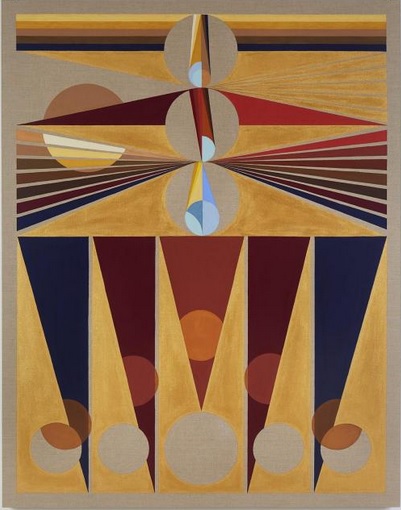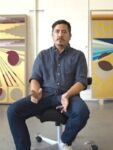
Eamon Ore-Giron
American, 1973-
Infinite Regress LXV, 2019
Flashe on linen
69 × 54 in.
SBMA, Museum purchase with funds provided by the General Art Acquisition Fund
2019.9

Eamon Ore-Giron photographed in his studio in Highland Park, East LA, in 2018.
COMMENTS
I first encountered Eamon Ore-Giron at the 2018 Made in LA exhibition at the Hammer Museum in Westwood—an experience that opened and expanded my understanding of geometric abstraction. He designed this work for the entrance wall, playing counterpoint with the lines of the stairway and railings. As the geometry interacts with the architecture, you feel the painting expanding into the surrounding space. From the vanishing point at left center, the space opens into the museum, entering not only our space but bringing with it a universe of time and meaning—an experiential global history conveyed not by words but by the sharing of evolving space. The modulating colors dramatize the radiation from the point of origin outward, ultimately including the whole gallery—and our world. The orbs, like individual moments, shift, change color and shape in response to the momentum of the whole, conveying an interactive shared universal existence without boundaries or limitations. The energy generated by this happening is palpable—exciting, optimistic, inclusive, welcoming. We must engage it on its terms, a felt experience, not an idea but a unique moment in time which touches us as something we perhaps already know, something we inherently recognize. Ore-Giron took the title “Black Angels” from the first lines of a Latin American poem which became a cover band song in the 1970s. “Painter that was born in these lands but with a ranger’s brush, would you paint me a black angel?”
Our painter, born in Tucson, Arizona, to an Irish mother and Peruvian father, is painting us black angels—or perhaps the passage of a Black Angel, bringing into our world a mythological presence and with it the precolonial culture from which it sprang. With the formality of a ritual, he paints the spirit, inclusivity, history of black “angel”ness. The outsider painter re-translates Pan-American graphics from 13th century Peruvian textiles and stone pyramids as relevant in our world today. The glints of gold reflect Peruvian ritual ornaments and the melting of those objects for transport to Spain. Time and loss are shared, along with the spirit of the black angel, who is now welcomed.
Eamon Ore-Giron is widely educated through his own intellectual curiosity, travel and residency in Peru and Spain, as well as a BA from The San Francisco Art Institute and an MFA from UCLA. In 2020 he was awarded the Presidential Residency at the Anderson Collection at Stanford University. He is a founding member of OJO, a collaborative musical group which staged events involving the audience with the musicians in the performance, using Pan-American styles, simplified rhythms and improvisational guitar. The group produced videos and records and performed in many art museums and pubic venues from 2004-2013. More recently he has turned to painting and found that his graphics were shifting, flattening, as sight in his right eye deteriorates. His evolving style is best experienced in the series, Infinite Regress, of which our work currently in McCormick Gallery is one.
We’ll begin with the first Docent question, “What is flashe?” It’s a vinyl, opaque, flat paint made by the French company Lefranc Bourgeiois, designed in 1954 for stage set painting, and quickly adapted by artists who found it had ad-vantages over acrylic. It leaves no brush marks and dries to a soft, creamy, pliable-looking skin, adheres without a primer to all surfaces and resists the elements as it is elastic and permanent and does not fade. These attributes certainly explain why Ore-Giron chose it for his Hammer mural.
On to more esoteric concerns—what is “infinite regress?” It is an epistemological question of great interest, epistemology being the study of knowledge. Infinite regress proposes the possibility of a continuous cycle of related ideas which form a closed circuit, each leading back or forward to an-other. Ore-Giron is suggesting just such a uni-verse—one in which (for a rough example) the Peruvian pyramids, the Egyptian pyramids, the Alaskan totem poles relate to one another in expressing a common human desire or yearning or meaning which can be expressed in art. That is the artist’s proposal—that it is possible to understand the uni-verse as an interrelated knowing, that we are in-formed and enriched by the deep connections with the past which generate a new present, which is related to an ancient past. In this cycle of past and present there are no borders and no ending, offering the possibility of universal commonality.
In viewing other works from this series, we begin to get the feel of his constructs, the celestial zone above, our world below, a tangible force moving within or across the orbs as they transverse the space. Individual orbs respond in different ways, take on varying shapes, recalling Peruvian gold images now vanished, but retrieved here.
In Infinite Regress LCV Ore-Giron presents this interconnected informative process as an enhanced universe, balanced, rich, stable and beautiful. It is also in motion reaching back, pushing forward, generating energy. In 2020 Ore-Giron published a book entitled Infinite Regress containing his paintings in this series along with the poetry of Edgar Garcia, a Pan-American professor at the University of Chicago. You can join their conversation on U tube to get a first-hand experience of the artist.
- Ricki Morse, Time, Space and Connectivity: The Expansive Abstraction of Eamon Ore-Giron and Zach Harris, "La Muse", November, 2021
SBMA CURATORIAL LABELS
Los Angeles-based Ore-Giron roots his artistic inspirations in the arid landscape of the desert and the way in which colors reflect in the environment. Influenced by past and present cultures of the Americas, his work considers how language, history, and identity may be reflected in color and design. Infinite Regress LXV is part of a recent series of paintings exploring gold’s long history in South America, particularly Peru—the birth country of the artist’s father.
- In the Meanwhile Part II, 2021
